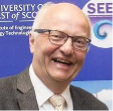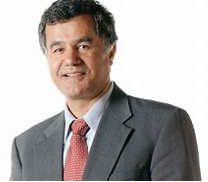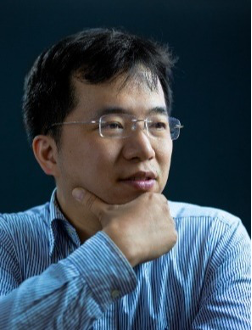KEYNOTE SPEAKERS
| Name: | Ibrahim Dincer |

|
| Biography: |
Ibrahim Dincer is a full professor of Mechanical Engineering at Ontario Tech. University. Renowned for his pioneering works in the area of sustainable energy technologies he has authored/co-authored many books and book chapters, along with many refereed journal and conference papers. Dr. Dincer has chaired many national and international conferences, symposia, workshops and technical meetings. Dr. Dincer has delivered many keynotes and invited lectures. Dr. Dincer is an active member of various international scientific organizations and societies, and serves as editor-in-chief, associate editor, regional editor, and editorial board member on various prestigious international journals. Dr. Dincer currently serves as President for Hydrogen Technologies Association in Turkey and Chair for Energy Working Group in Turkish Academy of Sciences. Dr. Dincer is a recipient of several research, teaching and service awards, including the Premier's research excellence award in Ontario, Canada. During the past nine years he has been recognized by Thomson Reuters as one of the Most Influential Scientific Minds in Engineering and one of the most highly cited researchers. During the past 25 years Dr. Dincer’s research and activities have been diverse and primarily focussed on sustainable energy solutions, sustainable communities and cities, district energy systems, green buildings, renewable energy technologies, energy storage technologies, hydrogen energy technologies, and waste to energy technologies. His group has developed various novel technologies for commercialization. He is known for his engineering education related talks as a committed educator. |
| Title: | Dimensions of Innovation and Its Role in Energy Storage Systems Design and Development |
| Abstract: |
Innovation is considered a critical element in making difference and distinguishing products, technologies, services and simply anythingelse. It is also linked to research and becomes a crucial step in bridging research to commercialization resulting in technology development. This makes it multidimensional and essential to consider when energy storage research is dealt with. So, we are in an era where we think innovatively, do research innovatively, develop solutions innovatively and implement innovatively. In this talk, the focus will first be placed on research, innovation, technology development and commercialization concepts and their linkages to the design and development of energy storage systems. There will be cutting-edge research results on innovatively designed and developed systems, ranging from hydrogen storage to battery thermal management as well as from conventional modes to hybrid modes. There will be integrated systems designed where energy storage options are innovatively incorporated. The system performance aspects will consider both energy and exergy criteria for better design and implementation practices. There will be numerous illustrative examples and case studies along with cutting-edge applications presented. |
| Name: | Henrik Lund |

|
| Biography: |
Henrik Lund is a professor of energy planning at Aalborg University in Denmark. He holds a Ph.D. in Implementation of Sustainable Energy Systems (1990), and a Dr. Techn. in Choice Awareness and Renewable Energy Systems (2009). Henrik Lund has many years of management experience as head of department for approx. 200 staff persons (1996-2002), head of the section for approx. 50 persons (2014 – 2016) and head of a research group of 20-30 persons (2002 – present). During his time, the Sustainable Energy Planning research group at Aalborg University has grown to approx. 30 staff members, including 5 professors. Henrik Lund is editor-in-chief of Elsevier’s high-impact journal Energy (Elsevier, IF=9, CiteScore=14.9).. Henrik Lund is the author of more than 400 books and articles, including the book ''Renewable Energy Systems”. He is the architect behind the advanced energy system analysis software EnergyPLAN, a freeware that has formed the basis of more than 100 peer-reviewed journal papers worldwide. |
| Title: | Towards an Energy Efficient and Affordable Green Energy Transition: The Cases of Denmark and Europe |
| Abstract: |
This presentation focusses on how societies can design and achieve resilient and fully decarbonization energy systems based on renewable energy. The presentation addresses a set of methods and criteria to design Smart Energy Systems, while considering the context of 100% renewable energy on a national level. Countries should handle locally what concerns local demands, and at the same time acknowledge the international context when discussing resources and industrial and transport demands. Following such approach will also lead to a resilient energy solution. To illustrate the method, it is applied to the cases of Denmark and European within the context of a global fully decarbonized energy system. The goals of the Danish Government supported by the Danish Parliament is to reduce Greenhouse gas emissions by 70% in 2030 and to achieve a net zero emission society by 2050. Moreover, due to the war in Ukraine, there is also a strong wish for a resilient energy supply. This presentation includes a list of theoretical and methodological considerations as well as a concrete proposal on how such targets can be implemented. It is highlighted that already now one must think beyond 2030 to prepare for the next step to achieve a full decarbonization by 2040 or 2050. It is also highlighted that a country such as Denmark must consider how to include its share of international shipping and aviation as well as how to design a solution with Denmark’s share of sustainable biomass resources. Moreover, the presentation includes the results of detailed hourly modelling of the EU “A Clean Planet” scenarios for a fully decarbonized Europe in 2050 and compare it to a “smart energy systems” alternative. The case illustrates how the focus on a fully sector-coupling as expressed in a smart energy systems approach will lead to higher energy efficiency and the identification of a more affordable green transition in Europe. |
| Name: | Fariborz Haghighat |

|
| Biography: |
Dr. Fariborz Haghighat is a professor at the Department of Building, Civil and Environmental Engineering – Concordia University, Canada. His current research focuses on the fundamental of heat and mass transport in the built environment, and on its applications in the design and analysis of energy-efficient, healthy/immune, and sustainable buildings/communities. Dr. Haghighat led two Annexes of the International Energy Agency (ECES/IEA); Annex 23 of the International Energy Agency “Appling Energy Storage in Buildings of the Future – Annex 23” and “Integration of Energy Storage with buildings and Communities: Optimization and Automation – Annex 31”. He has been involved in a number of the IEA projects, and responsible for a number of national and international projects. Professor Haghighat is a Fellow of the ASHRAE and an elected member of the International Academy of Indoor Air Science. He is the Editor-in-chief of the International Journal of Sustainable Cities and Society and the Co-Editor-in-chief of the International Journal of Energy and Built Environment, and a member of the Editorial Board of several international scientific journals. He has published more than 300 journal and conference papers and presented numerous talks on selected aspects of Energy and Environment. |
| Title: | Integration of Thermal Energy Storage Systems with Buildings: Design and Operation |
| Abstract: |
The building sector contributes immensely to the total energy consumption, particularly for its space conditioning and demotic hot water. Evidence from a variety of research suggests that the built environment contributes substantially to global energy consumption and to the production of greenhouse gases that impact climate change: buildings use about 40% of the world-wide total energy and contribute up to 35% of Greenhouse Gases (GHG). To resolve this, efficient utilization of energy sources is considered to be a potential alternative to meet the increasing energy demand in buildings. Statistical data convey that the power generation from renewables grew by 17% in 2017, contributing to 8% of the global electricity. Given the current concerns about declining conventional energy resources and climate, it is evident that there is a growing requirement to incorporate a sustainable design into energy buildings capable of managing and maintaining the required indoor environment while minimizing the environmental impact. At present, the energy requirements in buildings are majorly met from non-renewable sources and the contribution of renewable sources is still in its initial stage. Meeting the peak energy demand by non-renewable energy sources is highly expensive for the utility companies and it critically influences the environment through GHG emissions. In addition, renewable energy sources are inherently intermittent in nature. Thus, thermal energy storage has emerged as a promising solution for storing substantial energy for building applications. This study provides a comprehensive examination of thermal energy storage systems with a focus on their application in buildings, and then demonstrate its application through few case studies in cold climate and warm climate. |
| Name: | Prof. Dr. Qiang Zhang |

|
| Biography: |
Dr. Qiang Zhang is a full professor at the Chemical Engineering Department, Tsinghua University, China. He is awarded as Zhaowu Tian award from International Society of Electrochemistry, Science and Technology Award for Chinese Youth, and Distinguished Young Faculty of Ministry of Education. His current research interests are advanced energy chemistry and energy materials, including dendrite-free lithium metal anode, lithium sulfur batteries, and energy electrocatalysis, especially the structure design and full demonstration of advanced energy materials in working devices. He is the Advisor Editor of Angew Chem, Associate Editor of J Energy Chem & Energy Storage Mater. He is sitting on the advisory board of Joule, ChemSocRev, Chem Commun, J Mater Chem A, Adv Energy Mater, Adv Funct Mater, Matter, Energy Adv, Sci China Chem, Mater Futures, and so on. He is the deputy head of the expert group on energy storage and smart grid of the national key research and development plan. He has won the first prize of Natural Science of the Ministry of Education and the National Science Fund for Distinguished Young Scholars. |
| Title: | The Promotion of Emerging Energy Materials for Next-Generation Batteries through Lithium Bond Chemistry |
| Abstract: |
As one of the most important applications of the element, Li batteries afford emerging opportunities for the exploration of Li bond chemistry. In this talk, the historical development and concept of the Li bond are reviewed, in addition to the application of Li bonds in lithium-sulfur batteries. The Li bond was described in the context of Li batteries, including discussions of sulfur cathodes, liquid electrolytes, and Li metal anodes. Such discourse on the chemistry of the Li bond can provide fruitful insight into the fundamental interactions within lithium-sulfur batteries and thus deliver a deeper understanding of their working mechanism. |
| Name: | Prof. Donghai Wang |

|
| Biography: |
Prof. Donghai Wang is a Professor in Department of Mechanical Engineering and Institute of Energy and the Environment at the Pennsylvania State University. Dr. Donghai Wang is a well-known researcher in developing new materials and techniques for energy storage technologies. He has been an ardent researcher responsible for leading multiple-organization interdisciplinary teams, executing over $22M grants as principal investigators and co-investigators, and overseeing 50 doctoral students and postdoctoral fellows. He has co-authored around 120 peer-reviewed journal articles with an H-index of 76 (Google Scholar) and given over 100 talks at professional conferences and universities. He was identified as a Highly Cited Researcher in 2018-2022 according to Web of Science. Dr. Wang is a prolific inventor with over 20 applications filed in the fields of nanomaterials and related applications to energy storage techniques. |
| Title: | Next-generation Electrochemical Energy Storage Technologies for Electrification and Decarbonization |
| Abstract: |
Achieving an electrified and decarbonized world hinges upon establishing a resilient grid and advancing power systems with exceptional efficiency, reliability, functionality, and form factor. With current efforts in electrification and decarbonization in transportation and industry, there is a clear need to develop high-performance, safer, and more sustainable energy storage technologies to advance current grid and power systems. Material development plays an important role in realizing sustainable, high-performance energy storage technologies such as next-generation Li-ion, Li metal, Na-ion, and solid-state batteries. In this talk, I will give an overview of energy storage technologies currently used in transportation and stationary applications, cover the development of electrode materials for next-generation Li-ion batteries, and present approaches to developing high-performance solid-state batteries. I would like to demonstrate the research effort aiming to build knowledge and understanding of critical electrochemical processes and to employ the desired features in electrochemical energy storage technologies to meet the requirements of electrification and decarbonization across the world. |






